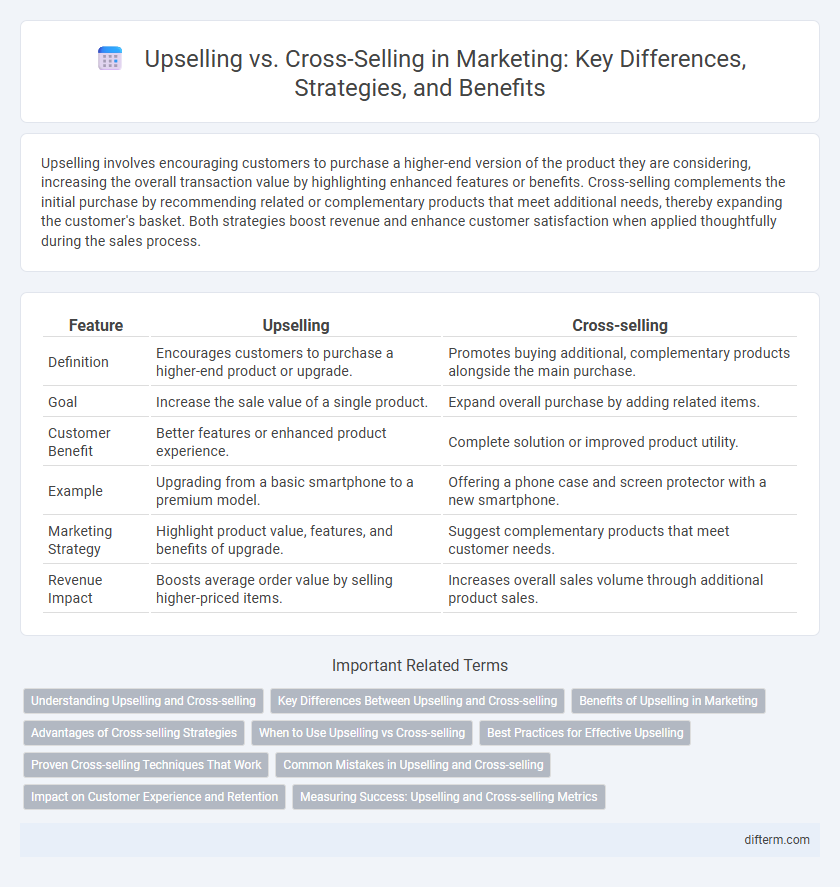Upselling involves encouraging customers to purchase a higher-end version of the product they are considering, increasing the overall transaction value by highlighting enhanced features or benefits. Cross-selling complements the initial purchase by recommending related or complementary products that meet additional needs, thereby expanding the customer's basket. Both strategies boost revenue and enhance customer satisfaction when applied thoughtfully during the sales process.
Table of Comparison
| Feature | Upselling | Cross-selling |
|---|---|---|
| Definition | Encourages customers to purchase a higher-end product or upgrade. | Promotes buying additional, complementary products alongside the main purchase. |
| Goal | Increase the sale value of a single product. | Expand overall purchase by adding related items. |
| Customer Benefit | Better features or enhanced product experience. | Complete solution or improved product utility. |
| Example | Upgrading from a basic smartphone to a premium model. | Offering a phone case and screen protector with a new smartphone. |
| Marketing Strategy | Highlight product value, features, and benefits of upgrade. | Suggest complementary products that meet customer needs. |
| Revenue Impact | Boosts average order value by selling higher-priced items. | Increases overall sales volume through additional product sales. |
Understanding Upselling and Cross-selling
Upselling involves encouraging customers to purchase a higher-end product or an upgrade of the original item, increasing transaction value through enhanced features or premium versions. Cross-selling promotes complementary or related products alongside the primary purchase, aiming to satisfy broader customer needs and boost overall sales volume. Effective implementation of both strategies relies on deep customer insights and targeted recommendations to maximize revenue and improve customer satisfaction.
Key Differences Between Upselling and Cross-selling
Upselling involves encouraging customers to purchase a higher-end version or upgrade of the product they are considering, increasing the overall sale value. Cross-selling promotes buying complementary or related products alongside the primary purchase to enhance the customer's experience and basket size. The key difference lies in upselling targeting a better or more expensive item, while cross-selling focuses on additional items that complement the original choice.
Benefits of Upselling in Marketing
Upselling enhances customer lifetime value by encouraging purchases of higher-end products or premium versions, increasing average order value and driving revenue growth. It builds stronger customer relationships by offering tailored solutions that better meet client needs, leading to higher satisfaction and loyalty. Effective upselling strategies also optimize marketing efforts by leveraging customer data to present relevant upgrades, improving conversion rates and maximizing marketing ROI.
Advantages of Cross-selling Strategies
Cross-selling strategies enhance customer lifetime value by encouraging the purchase of complementary products, thereby increasing overall sales without the need for acquiring new customers. These tactics improve customer satisfaction by offering tailored product recommendations that meet diverse needs and preferences. Businesses leveraging cross-selling benefit from higher average transaction values and strengthened customer loyalty through personalized shopping experiences.
When to Use Upselling vs Cross-selling
Upselling is most effective when customers have already shown interest in a product and are considering a purchase, enabling marketers to offer premium versions or add-ons that enhance the original choice. Cross-selling works best when customers complete a transaction, allowing businesses to suggest complementary products or services that increase overall value and improve customer experience. Knowing the customer journey and purchase intent helps marketers decide whether upselling or cross-selling will maximize revenue and satisfaction.
Best Practices for Effective Upselling
Effective upselling hinges on understanding customer needs and offering relevant product upgrades that enhance value without overwhelming buyers. Personalization through data analytics enables marketers to present timely, context-aware suggestions that align with consumer preferences and purchasing behavior. Clear communication of benefits and limited-time incentives further increase the likelihood of successful upsell conversions.
Proven Cross-selling Techniques That Work
Proven cross-selling techniques that work include personalized product recommendations based on customer purchase history, bundling complementary items to enhance value, and leveraging targeted email campaigns with tailored offers. Data-driven insights enable marketers to identify relevant products that meet customer needs, increasing average order value and customer satisfaction. Utilizing behavioral analytics also helps optimize timing and messaging for cross-selling efforts, resulting in higher conversion rates.
Common Mistakes in Upselling and Cross-selling
Common mistakes in upselling and cross-selling include pushing irrelevant products that do not align with the customer's needs, leading to decreased trust and satisfaction. Overwhelming customers with aggressive offers can result in negative brand perception and lost sales opportunities. Failing to personalize recommendations based on customer data reduces the effectiveness of both upselling and cross-selling strategies.
Impact on Customer Experience and Retention
Upselling enhances customer experience by offering premium product options that better meet their needs, increasing satisfaction and perceived value. Cross-selling expands customer choices by suggesting complementary products, fostering convenience and creating a more personalized shopping journey. Both strategies, when executed thoughtfully, drive higher retention rates by deepening customer engagement and building long-term loyalty.
Measuring Success: Upselling and Cross-selling Metrics
Tracking average order value (AOV) and customer lifetime value (CLV) provides critical insight into upselling success by highlighting increased purchase amounts and repeat business. Cross-selling efficiency is measured through metrics such as attach rate, which quantifies the proportion of customers purchasing complementary products alongside primary items. Monitoring conversion rates and revenue per visit further refines the evaluation of both strategies, ensuring optimized marketing efforts and maximized revenue growth.
Upselling vs Cross-selling Infographic

 difterm.com
difterm.com